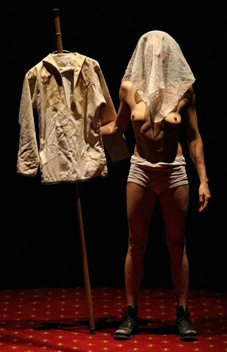the body inside and out
kavita bedford sees acrobat's smaller, poorer, cheaper

Jo Lancaster, Acrobat
photo John Sones
Jo Lancaster, Acrobat
JO LANCASTER APPEARS ALONE IN AN UNADORNED PERFORMANCE SPACE, NAKED BAR A PAIR OF BLUNDSTONE BOOTS. SHE STROLLS OVER TO A BASKET, PULLS ON UNDERWEAR AND TURNS, TONGUE IN CHEEK, BRANDISHING HER BOTTOM AT THE AUDIENCE AND WHIRLING A HULA HOOP. THERE IS A SENSE OF MISCHIEVOUSNESS AS SHE PLAYS ON THE AUDIENCE’S FEELING OF AWKWARDNESS. ACROBAT’S SMALLER, POORER, CHEAPER CHALLENGES CONVENTIONAL ROLES FOR THE BODY AND THE PHYSICAL EXPECTATIONS PLACED ON IT, QUESTIONING WHAT HAPPENS WHEN WE SHED OUR INHIBITIONS ALONG WITH OUR CLOTHING AND EXPOSE THE VULNERABLE BODIES BENEATH.
Lancaster’s fun-loving opening tumbles, turns and spins are suddenly interrupted by a marriage to a clothes horse. This woman’s freedom is abruptly exchanged for a vacuum cleaner thrust into her hands by a stage assistant. There is something eerie about the way she rocks it like a baby. Now, the cold, hard metallic object restricts her freedom as it lies cradled in her arms. In a final mockery of domesticity, she attaches the suction valve of the vacuum to her breast, creating an image of a suckling parasite.
Lancaster, Simon Yates and Mozes Taplin each perform solo acts exploring how the body is shaped and re-shaped by warring social forces. As in the theories of Foucault, the body becomes a surface on which events are inscribed. The play between the naked body and the meaning of clothing threads through the work.
Placing a giant sheet of butcher’s paper on the floor, Lancaster creases the sheet as if practising origami. She reveals her creation: a dress. It is striking the way domesticity keeps defining her actions. Even now she is, in a sense, folding her own clothes. She holds the dress against her body and, in big child-like scrawling texta, draws scenes of typical suburbia. In a violent movement she suddenly rips a hole in the dress over her genitalia, exposing a crude gash amongst the pretty scenes of flora and picket fences.
With the appearance of Mozes Taplin comes a magical exploration of the contrast between the public and private self. He brandishes a scarf and appears to lose it in various parts of his body. The trick turns into a flirty striptease that tests the boundaries between private whim and public performance.
In the starkest scene of all Taplin, tautly entwined by a rope, tumbles from a height, the cord cutting into and marking his flesh. The temporary etchings that cover his skin remind us of the way people score and brand their bodies as a form of self- expression. ‘Blood’ (in the form of paint) seeps down the rope and, suddenly, it is everywhere, splattering the performance space. It is a violent act and the painfulness of the scene is underscored by a haunting sound-score by Tim Barrass. Sounds of insatiable hunger, gulping and sucking, echo through the room like a soul being wrung from its body. Pre-recorded and live sounds are mixed by the composer onstage creating a metallic, electronic rhapsody.
In another twist to the categories on interior and exterior, traditional ‘behind the scenes’ artists appear onstage, integrated into the performance. The stage operator, Alex White, drolly walks across the space with a placard reading “And now for something a bit lighter.” At another point the audience watch as the performers, with the aid of the stage hands, elaborately and dramatically set up a catapult act using a punching bag as the weight, only to parody the feat in a contrived anti-climax.
Smaller, poorer, cheaper is hilarious and frank physical theatre performance in which the body is constantly revealed in more ways than one. We leave the theatre with a heightened awareness of what we could achieve with our own.
Acrobat, Smaller poorer cheaper, Performance Space, CarriageWorks, Sydney, March 28-April 1
RealTime issue #81 Oct-Nov 2007 pg.






